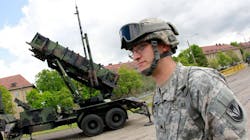Military forces increase their attention on counter-drone attack technologies to reduce the unmanned threat
WASHINGTON – Lasers, interceptor missiles and electronic warfare are all fast-growing potential answers to a seemingly unstoppable increase in enemy drone attack technologies. Kris Osborn at The National Interest reports. Continue reading original article
The Military & Aerospace Electronics take:
15 April 2020 -- Given the rapid pace of technological advancement, and the seemingly ubiquitous availability of unmanned aerial vehicle (UAV) technologies, the U.S. military is moving quickly to keep pace -- and stay in front of possible drone swarm attacks, close-in drone-fired weapons, and even instances wherein drones themselves become explosives.
In an effort to address this, the Army and Raytheon are now accelerating development and deployment of an upgraded counter-drone weapons system designed specifically to address close-in small drone threats.
The integrated counter-drone system uses a Ku band mobile, 360-degree ground radar called Ku-band Radio Frequency System (KuRFS) -- in conjunction with a suite of specific countermeasures, called effectors. KuRFS can provide threat information for ground commanders who can then opt to use laser countermeasures, EW, High-Powered Microwave weapons or a kinetic energy interceptor missile-drone called Coyote Block 2. However, before any threat can be destroyed, it must first be identified or “seen.”
Related: The new world of counter-drone technology
John Keller, chief editor
Military & Aerospace Electronics

